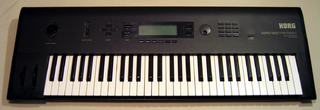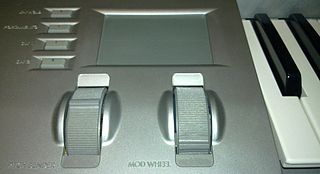Subtractive synthesis is a method of sound synthesis in which partials of an audio signal are attenuated by a filter to alter the timbre of the sound. While subtractive synthesis can be applied to any source audio signal, the sound most commonly associated with the technique is that of analog synthesizers of the 1960s and 1970s, in which the harmonics of simple waveforms such as sawtooth, pulse or square waves are attenuated with a voltage-controlled resonant low-pass filter. Many digital, virtual analog and software synthesizers use subtractive synthesis, sometimes in conjunction with other methods of sound synthesis.
Wavetable synthesis is a sound synthesis technique used to create periodic waveforms. Often used in the production of musical tones or notes, it was first written about by Hal Chamberlin in Byte's September 1977 issue. Wolfgang Palm of Palm Products GmbH (PPG) developed it in the late 1970s and published in 1979. The technique has since been used as the primary synthesis method in synthesizers built by PPG and Waldorf Music and as an auxiliary synthesis method by Ensoniq and Access. It is currently used in hardware synthesizers from Waldorf Music and in software-based synthesizers for PCs and tablets, including apps offered by PPG and Waldorf, among others.

A sampler is an electronic or digital musical instrument which uses sound recordings of real instrument sounds, excerpts from recorded songs or found sounds. The samples are loaded or recorded by the user or by a manufacturer. These sounds are then played back by means of the sampler program itself, a MIDI keyboard, sequencer or another triggering device to perform or compose music. Because these samples are usually stored in digital memory, the information can be quickly accessed. A single sample may often be pitch-shifted to different pitches to produce musical scales and chords.

A digital audio workstation (DAW) is an electronic device or application software used for recording, editing and producing audio files. DAWs come in a wide variety of configurations from a single software program on a laptop, to an integrated stand-alone unit, all the way to a highly complex configuration of numerous components controlled by a central computer. Regardless of configuration, modern DAWs have a central interface that allows the user to alter and mix multiple recordings and tracks into a final produced piece.
The Yamaha AN1x is a DSP-based analog modeling synthesizer, produced by Yamaha Corporation from 1997 to 1998, and was marketed as an "analog physical modelling control synthesizer".
Phase distortion (PD) synthesis is a synthesis method introduced in 1984 by Casio in its CZ range of synthesizers. In outline, it is similar to phase modulation synthesis as championed by Yamaha Corporation, in the sense that both methods dynamically change the harmonic content of a carrier waveform by influence of another waveform (modulator) in the time domain. However, the application and results of the two methods are quite distinct.
Reaktor is a graphical modular software music studio developed by Native Instruments (NI). It allows musicians and sound specialists to design and build their own instruments, samplers, effects and sound design tools. It is supplied with many ready-to-use instruments and effects, from emulations of classic synthesizers to futuristic sound design tools. In addition, more than 3000 free instruments can be downloaded from the growing User Library. One of Reaktor's unique selling points is that all of its instruments can be freely examined, customized or taken apart; Reaktor is a tool that effectively encourages reverse engineering. Reaktor Player is a free limited version of the software that allows musicians to play NI-released Reaktor instruments, but not edit or reverse-engineer them.

The Moog synthesizer is a modular synthesizer developed by the American engineer Robert Moog. Moog debuted it in 1964, and Moog's company R. A. Moog Co. produced numerous models from 1965 to 1981, and again from 2014. It was the first commercial synthesizer, and is credited with creating the analog synthesizer as it is known today.

Waldorf Music is a German synthesizer company. They are best known for the Microwave wavetable synthesizer and Blofeld virtual analogue synthesizer.
The Yamaha TX81Z is a rack version of Yamaha DX11 and rack-mounted (keyboard-less) frequency modulation music synthesizer, which was released in 1987. Unlike previous FM synthesizers of the era, the TX81Z was the first to offer a range of oscillator waveforms other than just sine waves, conferring the new timbres of some of its patches when compared to older, sine-only FM synths. The TX81Z has developed a famous reputation, largely based on some of its preset bass sounds. A keyboard version with more onboard editing abilities was released the following year as the Yamaha DX11.

The Korg DW-8000 synthesizer was an eight-voice polyphonic hybrid digital-analog synthesizer 61-note keyboard instrument released in 1985. By the time of its launch Korg had already begun a common trend in 1980s synthesizer design: using numerical codes to access or change parameters with its predecessor - the Korg Poly-61, which was widely regarded as the company's first 'knobless' synthesizer. This was a move away from the heavily laden, complex control panels of earlier designs.
Polyphony is a property of musical instruments that means that they can play multiple independent melody lines simultaneously. Instruments featuring polyphony are said to be polyphonic. Instruments that are not capable of polyphony are monophonic or paraphonic.

The Korg Wavestation is a vector synthesis synthesizer first produced in the early 1990s and later re-released as a software synthesizer in 2004. Its primary innovation was Wave Sequencing, a method of multi-timbral sound generation in which different PCM waveform data are played successively, resulting in continuously evolving sounds. The Wavestation's "Advanced Vector Synthesis" sound architecture resembled early vector synths such as the Sequential Circuits Prophet VS.

The Oberheim OB•12 is a Virtual Analog synthesizer, designed and realised by the Italian musical instrument manufacturer Viscount, in production between 2000 and 2005.
The Roland JD-990 Super JD is a module version of Roland JD-800 synthesizer with expanded capabilities, which was released in 1993. JD-990 is a multitimbral synthesizer utilizing 'wave-table' sample-based synthesis technology. It is equipped with 6 MB of ROM containing sampled PCM waveforms, four sets of stereo outputs that are assignable to individual, internal, instruments, and standard MIDI in/out/through ports. JD-990 has a large LCD display and programming takes place through a keypad on the front panel of the unit. The unit can generate multi-timbral sounds reminiscent of the vintage analogue synthesizers but is also capable of generation of modern digital textures. There are several expansion boards available for JD-990 that can be installed in the provided expansion slot in the chassis of the unit.

A synthesizer is an electronic musical instrument that generates audio signals. Synthesizers typically create sounds by generating waveforms, through methods including subtractive synthesis, additive synthesis and frequency modulation synthesis. These sounds may be altered by components such as filters, which cut or boost frequencies; envelopes, which control articulation, or how notes begin and end; and low-frequency oscillators, which modulate parameters such as pitch, volume, or filter characteristics affecting timbre. Synthesizers are typically played with keyboards or controlled by sequencers, software or other instruments, and may be synchronized to other equipment via MIDI.
Casio's SDSynthesizers were a late-1980s line of analog synthesizers featuring a resonant filter. SD synthesis was traditional DCO-analog synthesis, with the main difference being that some of the SD waveforms' harmonic spectrums changed temporally, or dynamically in relation to the amplitude envelope. SD synthesis is used in six Casio synthesizers and home keyboards released in 1987 and produced until 1991, when Casio exited the synthesizer market completely and focused solely on pure consumer keyboards. Due to some programming limitations plus Casio's poor marketing, the SD synths never gained wide popularity and are now fairly rare in the second-hand marketplace. There still exists a small but devoted fanbase who insist that SD synthesis, particularly as expanded in the high-end model HT-6000, was overlooked and highly underrated and today really rare
Massive is a commercial wavetable software synthesizer plugin manufactured by Native Instruments for use in professional audio production. It utilizes several wavetables and oscillators in the creation of synthetic timbres. The software can be used as a VST plugin within a digital audio workstation, or as a standalone program. Released in 2007, the plugin has gained widespread popularity in the electronic music field, and is one of the most popular synthesizer plugins for modern dance music production.

The Korg Z1 is a physical modelling sound synthesiser released in 1997. Touted as a polyphonic Prophecy, the Z1 implements 13 synthesis types, all derived from the original OASYS synthesizer.

The Yamaha DX21 is a digital controlled bi-timbral programmable analog synthesizer with a four operator synth voice generator which was released in 1985. It uses sine wave-based frequency modulation (FM) synthesis. It has two FM tone generators and a 32-voice random-access memory (RAM), 32 user voices and 128 read-only memory (ROM) factory preset sounds. As a programmable synth, it enables users to create their own unique synthesized tones and sound effects by using the algorithms and oscillators. The instrument weighs 8 kg (17.6 lbs). On its release, it sold for $795.









